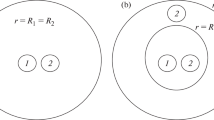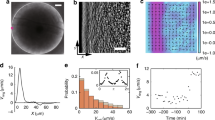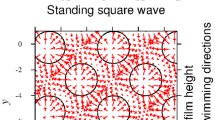Abstract
A theoretical model is proposed for the formation of cell distribution patterns in the slug stage of the cellular slime moldDictyostelium discoideum. The equilibrium distribution of two types of cells, prestalk and prespore, is obtained by minimizing the free energy, which is defined in terms of differential chemotaxis, differential cell adhesion and randomness of cell movement. Resulting distributions show various segregation patterns of cell types. The condition for cell sorting is obtained from stability analysis of the set of diffusion equations governing the evolution of cell type distribution and the concentration of chemoattractant. The intensities of differential chemotaxis and random cell movement are quantitatively evaluated from experimental data to show that two cell types can sort themselves completely by these forces.
Similar content being viewed by others
Literature
Belintsev, B. N. 1984. The spatial form self-organization in the development ofDictyostelium discoideum.J. theor. Biol. 108, 123–129.
Bonner, J. T. 1967.The Cellular Slime molds, 2nd edn. Princeton: Princeton University Press.
Forman, D. and D. R. Garrod. 1977. Pattern formation inDictyostelium discoideum II. Differentiation and pattern formation in non-polar aggregates.J. Embriol. exp. Morph. 40, 229–243.
Goel, N., R. D. Campbell, R. G. R. Rosen, H. Martinez and M. Yčas. 1970. Self-sorting of isotropic cells.J. theor. Biol. 28, 423–468.
Inouye, K. and I. Takeuchi. 1979. Analytical studies on migrating movement of the pseudoplasmodium ofDictyostelium discoideum.Protoplasma 99, 289–304.
Inouye, K. and I. Takeuchi. 1980. Motive force of the migrating pseudoplasmodium of the cellular slime mouldsDictyostelium discoideum.J. cell Sci. 41, 53–64.
Kakutani, T. and I. Takeuchi. 1986. Characterization of anterior-like cells inDictyostelium discoideum as analyzed by their movement.Develop. Biol. 115, 439–445.
Keller, E. F. and L. A. Segel. 1970. Initiation of slime mold aggregation viewed as an instability.J. theor. Biol. 26, 399–415.
Lam, T. Y., G. Pickering, J. Geltosky and C. H. Siu. 1981. Differential cell cohesiveness expressed by prespore and prestalk cells ofDictyostelium discoideum.Differentiation 20, 22–28.
Landau, L. D. and E. M. Lifshitz. 1959.Fluid Mechanics (translated by J. B. Sykes and W. H. Reid). Oxford: Pergamon Press.
MacWilliams, H. K. and J. T. Bonner. 1979. The prestalk-prespore pattern in cellular slime molds.Differentiation 14, 1–22.
Matsukuma, S. and A. J. Durston. 1979. Chemotactic cell sorting inDictyostelium discoideum.J. Embryol. exp. Morph. 50, 243–251.
Murray, J. D. 1989.Mathematical Biology. Berlin: Springer-Verlag.
Pate, E. F. and H. G. Othmer. 1986. Differentiation, cell sorting and proportion regulation in the slug stage ofDictyostelium discoideum.J. theor. Biol. 118, 301–319.
Prigogine, I. and R. Defay. 1950.Traité de Thermodynamique conformément aux méthodes de Gibbs et De Donder, Tome I: Thermodynamique chimique. Liège: Editions Desoer.
Rubinow, S. I., L. A. Segel and W. Ebel. 1981. A mathematical framework for the study of morphogenetic development in the slime mold.J. theor. Biol. 91, 99–113.
Segel, L. A. 1984.Modeling Dynamic Phenomena in Molecular and Cellular Biology, Cambridge: Cambridge University Press.
Sekimura, T. and Y. Kobuchi. 1986. A spatial pattern formation model forDictyostelium discoideum.J. theor. Biol. 122, 325–338.
Steinberg, M. S. 1963. Reconstruction of tissues by dissociated cells.Science 141, 401–408.
Sternfeld, J. and C. N. David. 1981. Cell sorting during pattern formation inDictyostelium discoideum.Differentiation 20, 10–21.
Takeuchi, I., M. Tasaka, M. Oyama, A. Yamamoto and A. Amagai. 1982. Pattern formation in the development ofDictyostelium discoideum. InEmbryonic Development, M. M. Burger and R. Weber (Eds), pp. 283–294. New York: Alan R. Liss.
Teramoto, E. 1985. An equilibrium theory of cell distribution inDictyostelium discoideum. InMathematical Topics in Population Biology, Morphogenesis and Neurosciences, E. Teramoto and M. Yamaguti (eds), Lecture Notes in Biomathematics No.71, pp. 217–223. Berlin: Springer-Verlag.
Umeda, T. 1989. A mathematical model for cell sorting, migration and shape in the slug stage ofDictyostelium discoideum.Bull. math. Biol. 51, 485–500.
Watts, D. J. 1987. Cell polarity and differentiation in cellular slime moulds. InSpatial Organization in Eukaryotic Microbes, R. K. Poole and A. P. J. Trinci (Eds). Special Publications of the Society for General Microbiology No.23, pp. 57–77. Oxford: IRL Press.
Williams, W. E. 1980.Partial Differential Equations. Oxford: Clarendon Press.
Author information
Authors and Affiliations
Rights and permissions
About this article
Cite this article
Umeda, T. A thermodynamical model of cell distributions in the slug of cellular slime mold. Bltn Mathcal Biology 55, 451–464 (1993). https://doi.org/10.1007/BF02460891
Received:
Revised:
Issue Date:
DOI: https://doi.org/10.1007/BF02460891




